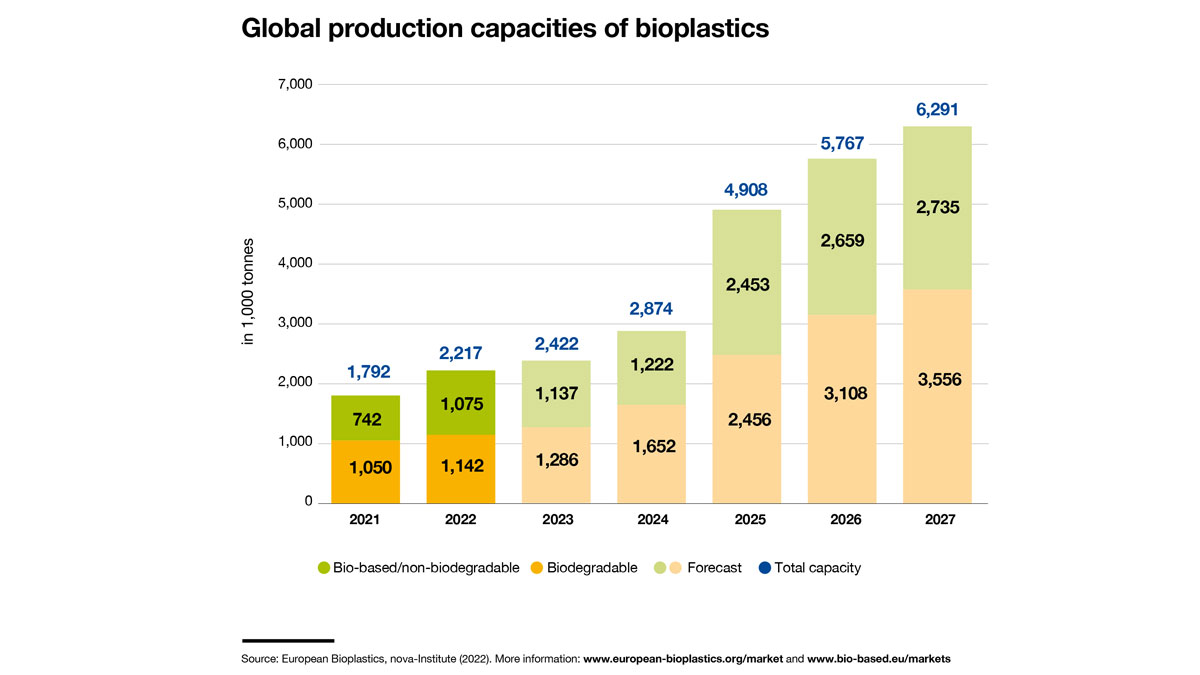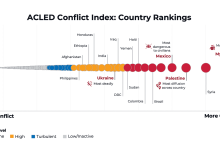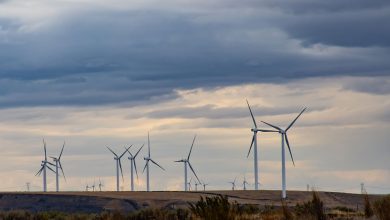Bioplastic, a False Solution of the Future?
Currently accounting for less than 1% of global plastics production, the volume of bioplastic production is expected to triple by 2027. As proof, more and more investments are announced in this area.
Since their large-scale production began in the 1950s, plastics derived from fossil fuels have made food safer to eat and vehicles safer to drive, yet plastics are considered one of the biggest threats to the environment and their production generates millions of tonnes of greenhouse gases every year.
So, at a time when the planet is increasingly troubled by the negative environmental impact of plastics produced by petrochemical plants, companies are investing billions of dollars to accelerate their production from natural and renewable products that will be safe to compost or degrade if the right conditions exist.
The emerging bioplastic industry is increasingly interested in materials extracted from corn, sugar, vegetable oils and other renewable substances, hoping to take a growing share of a market worth USD 600 billion worldwide.
Of the 9 billion tonnes of fossil fuel plastics produced since the 1950s, only 9% have been recycled, studies show. The rest has been buried in landfills or incinerated or pollutes land and waterways. Because of the chemical structure of plastics derived from fossil fuels, they can never completely decompose, but instead break down into smaller and smaller particles.
Bioplastic market to grow from USD 10.5 billion in 2021 to nearly USD 30 billion in 2028
Investors see bioplastics as a big opportunity. Data from the i3 Connect platform reveals that investment in bioplastic production reached USD 500 million in the first three months of 2022, compared to USD 350 million in the last quarter of 2021. The money comes from both companies and venture capitalists.
Zion Market Research calculates that the bioplastics market will grow from USD 10.5 billion in 2021 to nearly USD 30 billion in 2028.
Currently, there are two major types of bioplastics, PHA and PLA.
PHA can be produced with micro-organisms fermenting in rapeseed oil. This results in plastic balls that can be moulded to produce ordinary objects. PHA could biodegrade in six months in a marine environment and two years underground.
PLA is usually obtained from the fermentation of sugar that comes from corn and sugar cane. Unlike PHA, it does not readily biodegrade in nature and must be mixed with food waste in industrial composting plants. Buried, it would take decades to disappear.
‘Biodegradable’, an attractive term for marketing
The term biodegradable denotes the ability of a product to break down and be effectively ‘bio-assimilated’ by the environment under the action of micro-organisms and factors such as humidity, heat, or the presence of water. However, the use of the term ‘biodegradable’ for a product does not say anything about the speed of this degradation or about the particular conditions, not always met, under which such as material can be effectively ‘bio’-degraded. Therefore, it does not mean in any way that the product can be thrown into the environment without consequences. Experts advise us to avoid this term, which is often a sign of a company’s marketing approach. The European anti-waste law of 10 February 2020 also prohibits the application of the term ‘biodegradable’ to a product or packaging in the same way as the expression ‘environmentally friendly’, just as vague.
‘Compostable’ plastic is not necessarily circular
The concept of compostability of plastic materials has the merit of being more precise than that of biodegradability: it designates materials likely to degrade in the presence of organic waste and in composting conditions. There are two standards to qualify plastics as ‘compost’: the NF EN 13432: 2000 standard that designates plastics capable of degrading under industrial composting conditions. And the NF T 51-800: 2015 standard that designates plastics suitable for home composting.
Compostable plastic is not necessarily greener, and, above all, it is not a miracle solution to the problem of plastic pollution! Indeed, to be composted, this plastic must be sorted separately from the rest of the garbage with organic waste (food scraps) and directed to an industrial composting platform. Also, it should not represent a too large amount compared to organic waste to be able to effectively degrade. All these conditions are in reality difficult to fulfil.
Bioplastic critics
Critics of bioplastics made from corn and sugar point out that they are exploiting arable land on a starving planet.
The University Distinguished Professor in the Department of Chemical Engineering and Materials Science at Michigan State University – Ramani Narayan, has worked with various bioplastic companies over the years. He believes that some companies promote the ‘biodegradability’ of their products to make them more attractive. But the word is “misused, overused and abused, because everything on Earth is biodegradable, given enough time and the right environment.” He recognises that bioplastic degrade more easily than petrochemical plastic, which can take centuries to decompose. However, it should not be ignored, for example, that PHA degrades more slowly in cold water than in a warm atmosphere.
Major investors in the bioplastic industry: Europe’s first biorefinery
The Lower Seine industrial complex, recognised as a major petroplastic industry since the 1960s, is refocusing its compass on carbon-free polymers. After the US company Eastman, which is interested in molecular recycling to provide solutions for plastic waste, Belgium’s Futerro is now planning to set up a plant to produce PLA bioplastics from plant-based raw materials.
PLA, an industrially compostable bio-sourced plastic, is becoming increasingly popular due to its flexibility, near-glass-like transparency, and especially its carbon footprint which is about 80% lower than petroleum PET. It allows a multitude of applications: food films, automotive parts, 3D printing filaments, absorbable sutures.
Belgium’s Futerro group has decided two years after opening a double plant in China to build its first European biorefinery in Saint-Jean-de-Folleville, a town at the epicentre of the Port-Jérôme-sur-Seine petrochemical complex that many French people discovered during the refinery strike. The project should ensure an annual production of 75,000 tonnes.
This project, estimated at EUR 500 million, is a vertically integrated project involving the creation of 3 units:
- fermentation unit in which glucose will be converted into lactic acid;
- polymerisation unit that will convert lactic acid into PLA;
- PLA molecular recycling unit.
2.39 tonnes of corn, 0.37 hectares of land and 2921 m3 of water per tonne of PLA
A study by the German Federal Environment Agency showed that bioplastic had no better environmental impact than conventional plastic. The carbon footprint is certainly smaller, but the environmental impact is greater. The cultivation and processing of the plants needed to make bioplastic are particularly in question. Organic plastics are mainly made from sugar cane, corn, or potatoes. According to the Plastic Atlas Agency, it takes 2.39 tonnes of corn, 0.37 hectares of land and 2921 m3 of water to produce one tonne of PLA. The use of fertilisers to grow these crops is responsible for eutrophication of aquatic environments and acidification of soils to a greater extent than that generated by plastics manufacturing.
Another scientific analysis has shown that biodegradable plastic has very different degradation rates from one environment to another. PLA, for example, is not degradable in water. In order for bioplastic to break down, it must end up in appropriate composting systems. However, this happens very rarely because there is no collection network for compostable packaging. Recycling companies rarely allow bioplastic to rot for 12 weeks, as recommended for degradation. These are often limited to 4 weeks for economic reasons. There is also a lack of information on labels, which means that consumers rarely know which packaging is compostable. In Europe, most biodegradable plastics therefore end up in incinerators.
Conclusion
As part of its plastics strategy, the European Commission is supporting bioplastic as a sector of the future, bringing environmental and economic benefits. However, experts say it is far from green. Not only does it fail to solve the pollution problem, but it brings new risks to the planet.
There is an additional risk: by presenting bioplastic as environmentally friendly and safe, it could slow down efforts to reduce plastic production. Because this is the main strategy to adopt.
An environmentally friendly alternative to plastic
Chinese scientists have used proteins to create an eco-friendly plastic that is easy to engineer, biodegradable and biocompatible. This new plastic offers an alternative to ultra-polluting plastic for the environment and the body, according to the study published at the end of January 2023 in the journal Angewandte Chemie.
Researchers have developed a new method of producing protein-based plastic with high mechanical properties. To produce it, materials with two lysine-rich structural proteins are needed.
Firstly, proteins are extracted using microbial systems. Subsequently, they are purified and chemically cross-linked to polyethylene glycol derivatives via lysine side groups. Then, the stiffness of the bioplastic can be adjusted by adding different amounts of polyethylene glycol.
The result is a strong, transparent, and solvent-resistant bioplastic. This plastic has high mechanical strength at room temperature in all desired shapes. It has no toxic chemicals or complex processing steps such as liquefaction, extrusion or blow moulding.
However, there is one flaw to eliminate: it swells in water. But it can be used to seal wounds due to its haemostatic effects. According to the Chinese study, this new non-toxic bioplastic can be used to make toys, which can then be coloured with food dye.







